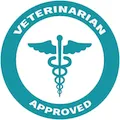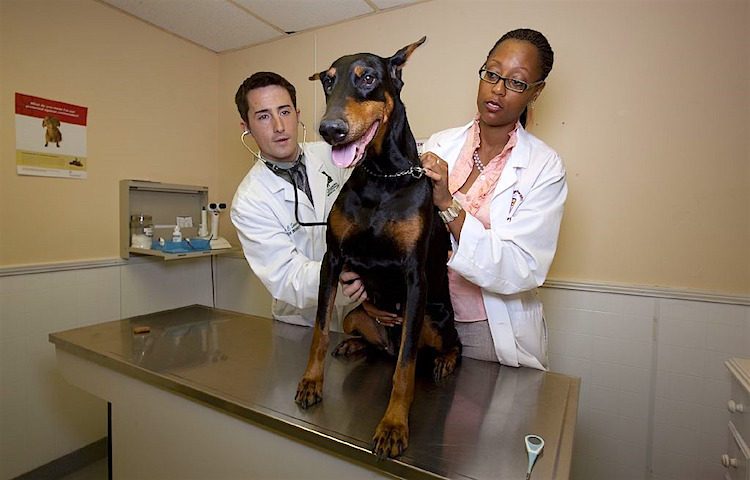
This pet health content that talks about common dog health problems was written by a veterinarian, Dr. Pippa Elliott, BVMS, MRCVS. It was last reviewed June 19, 2024
If you have questions or concerns, call your vet, who is best equipped to ensure the health and well-being of your pet. This article is for informational purposes only and is not a substitute for professional medical advice, diagnosis, or treatment. See additional information.

Understanding Common Dog Health Problems
What’s your best guess as to the most common dog health problems that people think are serious enough to bring their pups to the vet?
As a veterinarian, I frequently see tummy upsets, ear infections, itchy dogs, and issues with anal glands. Interestingly, one of the most common conditions dogs have, but their owners are often unaware of, is dental disease.
This list of the 10 most common canine conditions was compiled by a pet insurance company based on the reasons for claims. Learn more about anal glands and pet insurance.
10 Most Common Dog Health Problems
Soft Tissue Injuries
This covers everything from strains and sprains to skin lacerations and dog fight wounds. These conditions are largely accidental and part of being an active dog. Don’t let the risk of injury prevent you from taking your dog out and about — it’s what being a dog is all about.
Dental Disease
Severe dental disease can require medical and surgical intervention, including treating broken teeth, gum disease, or tooth root infections. A significant percentage of dogs have unrecognized dental disease. To check your dog’s dental health, try this simple sniff test:
- Put your nose next to the dog’s mouth.
- If you recoil in disgust or start gagging, the dog likely has a dirty mouth needing attention.
- Visit your vet if you notice this.
Learn more about your dog’s dental health.
Urinary Tract Infections
Signs of a urinary tract infection or cystitis include:
- Frequent urination
- Discomfort when urinating
- Blood in the urine
Seek urgent veterinary attention if you notice any of these signs. Cystitis can be uncomfortable, and its signs nonspecific. More serious is a bladder stone or debris blocking the bladder exit, requiring urgent treatment. Learn more about urinary tract infections and bladder stones.
Diarrhea
Diarrhea is a symptom with various causes, including:
- Parasites
- Infections
- Food allergies
- Garbage gut
- Bowel cancer
- Colitis
- Inflammatory bowel disease
If there’s no blood in the diarrhea and the dog seems otherwise fine, withhold food for 24 hours and reintroduce a bland diet for a few days. If there’s blood, vomiting, lethargy, or the dog seems unwell, consult a vet immediately. Learn more about the wide variety of causes.

Arthritis
Our dogs are living longer, so they are more likely to suffer from this common condition. Fortunately, there are now more ways than ever to give arthritic dogs back their quality of life, including:
- Recognizing pain and relieving it with appropriate medications and nutraceuticals that nourish the joints
- Trying physiotherapy, laser therapy, or stem cell therapy
Some vets have special arthritis clinics to advise on how best to manage the patient’s mobility. If your vet isn’t clued in, ask to be referred to a veterinary physiotherapist.
Vomiting
Vomiting in a dog should be taken seriously — the dog can quickly become dehydrated, which introduces a whole new set of problems. As a rule of thumb, visit the vet if the dog:
- Is depressed and vomiting
- Has been vomiting for more than 4 hours
- Also has diarrhea or if you see blood
Causes of vomiting include:
- A foreign body in the gut
- Parasites
- Infections
- Garbage gut
- Pancreatitis
- Disease elsewhere in the body causing toxicity (such as pyometra or kidney disease)
Benign Tumors
Benign tumors are unlikely to spread to other parts of the body or cause serious harm. Typical examples include lipomas (fatty lumps) or harmless skin lumps. The fact that benign tumors score highly on the list is encouraging because it indicates that people are being vigilant for lumps and bumps.
The good news is that the majority of these lumps, when investigated, are less serious. It’s pleasing to see that malignant cancer (aggressive cancers that spread and cause death) didn’t even make it into the top 10 most common dog health problems. This means benign lumps are far more common than malignant ones, although you should never be complacent — always get any lump checked out.
Hot Spots and Skin Infections
This just goes to prove how surprisingly fragile dog skin is. Canine skin is much thinner and less sophisticated than human skin, and when scratched or damaged, it’s more prone to infection. This makes sense — dogs also have a fur coat to protect their skin, making abrasions less likely.
You can help reduce the risk of skin infections by keeping their skin clean:
Was YOUR Pet Food Recalled?
Check Now: Blue Buffalo • Science Diet • Purina • Wellness • 4health • Canine Carry Outs • Friskies • Taste of the Wild • See 200+ more brands…

- Bathe the dog with a mild, moisturizing shampoo that helps wash bacteria from the skin’s surface.
- If the dog gets a scratch or abrasion, bathe it with salty water to help prevent infection.
Ear Infections
Ear infections are a common issue for dogs. For more detailed treatment, refer to this expert guide: “Ear Infection Treatment: From Ear Drops All the Way to Surgery.”

Skin Allergies (Atopy)
Wow! So our dogs’ most common problem is allergic skin disease. Skin allergies have a strong hereditary basis, so it looks like we’re breeding more and more dogs with sensitivities and allergies.
Signs of skin allergies in dogs include:
- Excessive paw licking
- Scooting and excessive bottom-licking
- Scratching
- Chewing
- Thickened skin
- Hair loss secondary to scratching
- Recurrent skin or ear infections
If your dog is super-itchy in the spring and summer but fine in the colder months, they might have allergic skin disease. It can only be controlled rather than cured.
Helping a dog with allergies means a multifaceted approach:
- Avoiding allergens
- Improving skin health
- Administering medication to reduce inflammation
For more information on scooting, check out this detailed guide.
Additional Information about Skin Issues in Dogs
Many dogs experience a variety of skin issues, including itching, scratching, and abnormal skin appearances due to allergies, parasites, or infections. Here are some common skin problems and their causes:
- Dermatitis: Inflammation of the skin caused by allergies or irritants.
- Hot Spots: Red, moist, hot lesions often caused by excessive licking or scratching.
- Mange: Skin disease caused by mites leading to hair loss and severe itching.
- Allergies: Triggered by food, environmental factors, or flea bites.
- Parasites: Fleas and mites causing intense itching and skin damage.
- Infections: Bacterial or fungal, leading to redness, swelling, and hair loss.
Regular vet visits are crucial to diagnose and manage these conditions effectively. Treatments may include:
- Medicated shampoos
- Antibiotics
- Antihistamines
- Dietary changes
For more detailed information, refer to the original article on The Spruce Pets.
Try brushing your dog’s teeth at home to avoid painful dental problems:
Final Thoughts on the Most Common Dog Health Problems
It’s interesting to consider how skewed this list might be since it was compiled by an insurance company. Minor issues like a runny eye or a broken dog nail may require only one visit and, therefore, may not be reflected in the insurance company’s data.
In my experience, the most common conditions that might not show up in the stats include:
- Garbage gut that settles after one visit
- Full anal sacs
These conditions, while common, often don’t lead to insurance claims but are still significant health concerns for dogs.
Frequently Asked Questions (FAQ)
what dog breed has the least health problems?
Mixed-breed dogs generally have the least health problems due to their diverse gene pool.
what dog has the most health problems
Bulldogs tend to have the most health problems because of their unique physical characteristics and selective breeding practices.



